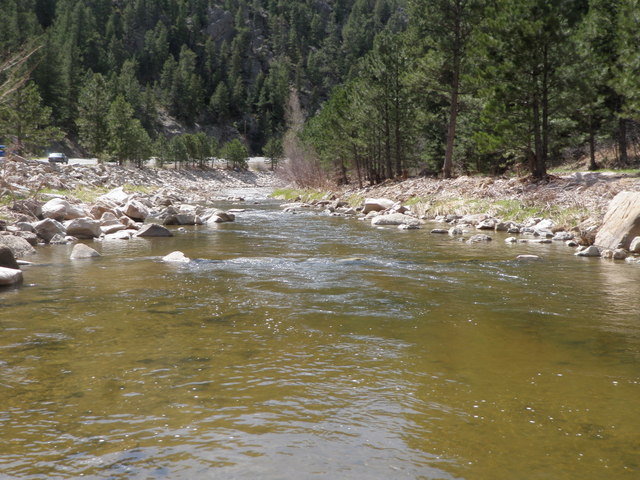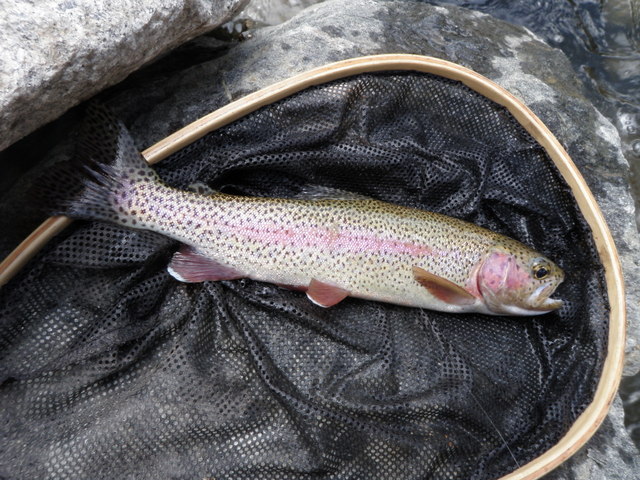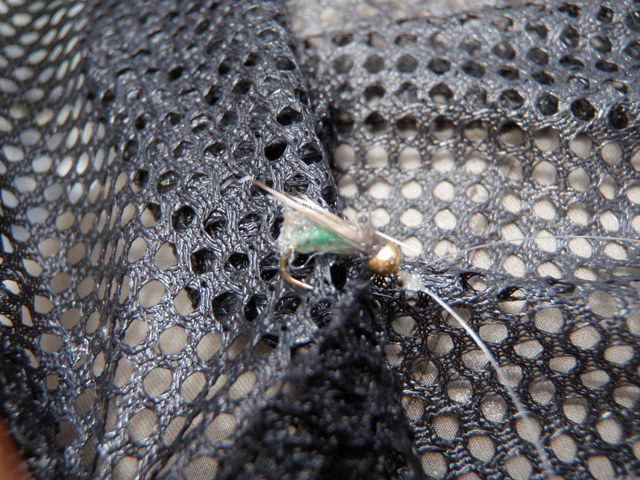Time: 10:30AM – 3:30PM
Location: Upstream from the border with the RV park that was destroyed in the September 2013 flood
Big Thompson River 08/03/2016 Photo Album
After three consecutive days of outstanding fishing, I was due for a reality check, and today August 3 served that purpose. Hopefully today’s results are not a sign that I need to select tailwaters and high elevation headwaters over lower valley rivers and streams at this early juncture in August. The high temperature reached 98 degrees in Denver, so I suspect heat is the main explanation for my slow day on the Big Thompson River. The DWR web site displayed flows of 103 cfs, and this is actually relatively high for early August, so I cannot blame the challenging fishing on the amount of water.
103 CFS
I arrived at a pullout along US 34 approximately six miles below Olympus Dam at 10AM, and by the time I assembled and rigged my Orvis Access four weight and gathered my fly fishing essentials, it was 10:30. I began fishing with a size 14 gray deer hair caddis, and three fish in the wide relatively smooth starting pool found it to their liking. The moderate flows enabled me to cross at the wide starting point, and I love the idea of fishing along the bank that is away from the road, so I adopted this approach. As I slowly moved up the river prospecting with the small caddis, I upped my fish count to four, but then the fish began to ignore my offering.
The type of water may have had something to do with this, since it transitioned into faster runs and pockets. In an effort to make my fly more visible to me and the fish, I swapped the size 16 caddis for a size 14 stimulator with a gray body. This change did not tempt the stream residents, so I defaulted to one of my favorite lineups. I tied a size 10 Chernobyl ant to my line and dangled a 20 incher and salvation nymph below it. By 11:45 as I climbed the rocky bank to return to the car for lunch, I added one more small fish to my tally, after it struck the salvation nymph, as I lifted to make another cast.
I walked back to the Santa Fe and executed a U-turn and parked high above my lunchtime exit point. I sat on a large rock with a great vantage point, while I munched my sandwich, but I failed to spot any insects or fish. It is very unusual not to see fish in the deep pools of the Big Thompson River.
After lunch I continued from my quitting point, and within minutes I was perched at the tail of a long deep run that transformed into a wide pool. The entire area was 25 yards long and the pool covered the entire width of the river. I made some long angled casts to cover the lane along the opposite bank, and I noticed a refusal to the Chernobyl, and the brief glimpse suggested a decent fish. In the midsection of the pool, another fish flashed to the top fly. What could these fish be looking for?
It was a bit late in the season for green drakes, but I recalled encountering them in the Big Thompson in prior years, so I decided to test one. I knotted a Harrop deer hair green drake to my line, and it also generated a look but no take. Next I switched to a size 14 parachute green drake, and the large low floating mayfly created interest from three fish that elevated to inspect and then turned away. I had one more style to try, so I tied a size 14 comparadun to my line, but this was totally ignored. Since the parachute style prompted the most action, I reverted to it. I made a forty-five degree cast up and across, and as the parachute drifted across from me, a decent brown trout rushed to the surface and nipped the fly. I felt weight for a split second, and then the fish was gone. After this weak endorsement of my offering I wasted an excessive quantity of additional futile casts, before I finally conceded defeat and moved on.
The next section of water consisted of large pockets and deep runs. The green drake induced a couple more refusals along the edge, so I gave in to my instincts and returned to the dry/dropper approach. Unlike earlier I selected a tan pool toy as my top fly and added a beadhead hares ear and salvation nymph.
The Fly Is Almost Larger Than the Fish’s Mouth
It was now early afternoon, and the intense rays of the sun were shining directly on the Big Thompson River. It was quite warm and bright, and I regretted not selecting wet wading for this unusually warm summer day in the mountains. Over the two and a half hours between 1:00 and 3:30, I worked my way upstream and covered a significant amount of water. I limited my casts to three or four and then moved on. I also attempted to focus more on the banks, although the level of the river and the large population of rainbows should have supported fish in the attractive pockets and pools in other places.
A Legacy Fly Accounted for Two Fish
I feel fortunate to report that I increased my fish count to eleven before I quit for the day. Three fish grabbed the salvation nymph, and one aggressive bank dwelling brown smashed the pool toy. Part way through this period of slow action, I decided to experiment with some old flies that I carry in my fleece pouch and rarely tie on my line. I grabbed a long narrow gray wet fly with a copper rib and replaced the hares ear. Miraculously this fly accounted for two small rainbows that snatched it, as it drifted through a run of moderate depth. This was probably the most significant positive for my day on the Big Thompson River on August 3.
Fish Landed: 11



